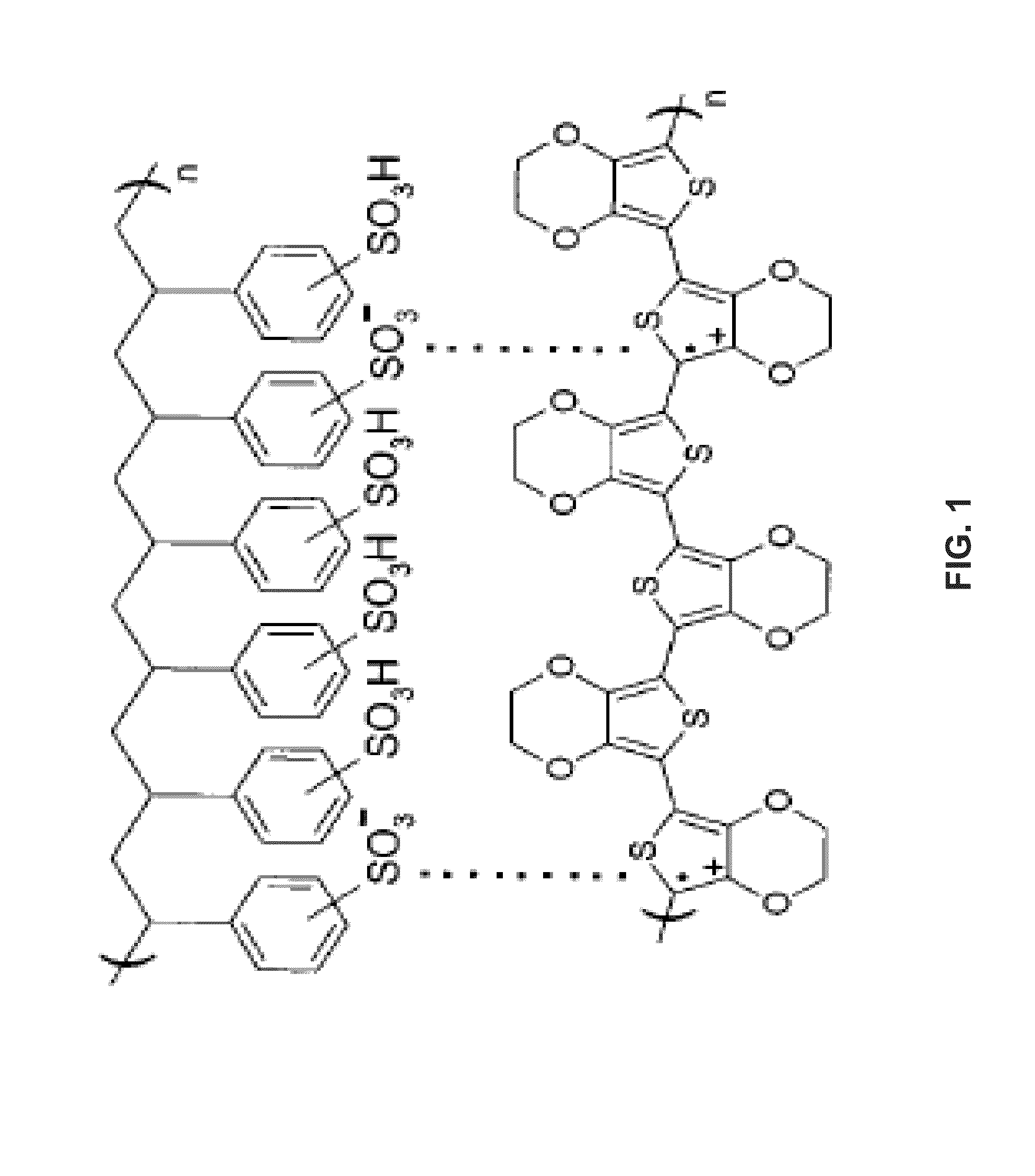Method of making conductive cotton using organic conductive polymer
a technology of organic conductive polymer and cotton, which is applied in the direction of non-conductive materials with dispersed conductive materials, dyeing process, textiles and paper, etc., can solve the problems of poor mechanical properties of organic conductive polymers, limited practical application of metal-fabrics beyond smart textiles and wearable computers, and high cost of excellent conductors
- Summary
- Abstract
- Description
- Claims
- Application Information
AI Technical Summary
Benefits of technology
Problems solved by technology
Method used
Image
Examples
example 1
Drop-Casting or Dip Coating of PED Titanium Dioxide (TiO2), Zinc Oxide (ZnO), Tin(IV) Oxide (SnO2), Antimony Doped Tin(IV) Oxide (ASnO2), Silica (SiO2), Carbon 0.1-*OT:PSS on Network Cotton Substrates
[0096]The conductive polymer that was used to prepare the electrical conductive cotton fabric is the commercially available Poly(3,4-ethylenedioxythiophene) Polystyrene sulfonate PEDOT:PSS (Clevios PH 1000) which has the chemical structure as shown in FIG. 1. PEDOT:PSS is known for qualities such as high conductivity, water dispersibility, environmental stability and easy processing. Furthermore, the inclusion of one or more polar organic solvents as a secondary dopant to PEDOT:PSS aqueous dispersion leads to enhanced conductivity.
[0097]All network cotton samples used had a same area of 1 in2 (1 in×1 in). FIG. 2 shows two different processes for fabricating conductive network cotton fabric.
[0098]Referring to FIG. 2, a polar solvent, such as dimethyl sulfoxide (DMSO), was added to the PE...
example 2
Energy Dispersive X-Ray Analysis of the Synthesized Conductive Cotton Fabric
[0102]The energy dispersive x-ray spectroscopy (EDX) analysis was carried out using scanning electron microscope (SEM) to identify the elemental composition of the original (untreated) cotton sample and the PEDOT:PSS-treated cotton. FIG. 3 shows the EDX spectrum for untreated cotton which revealed the presence of oxygen (O) and carbon (C) related to the cotton structure and the absence of the silicon escape peak at 1.74 keV. The absence of the peak at 1.74 eV confirmed that the cotton was silica-free. The spectrum of a PEDOT:PSS treated cotton, as shown in FIG. 4, indicates the absence of silica and also the presence of sulfur (S) which is related to the conductive polymer structure.
example 3
Sheet Resistance Studies of the Synthesized Conductive Cotton Fabric
[0103]The electrical resistance R of each sample was calculated from the current-voltage curve (I-V), as shown in FIGS. 5A-5J at varying concentrations of PEDOT:PSS which show ohmic behavior. Characterization was carried out using four probe techniques. Then the sheet resistance Rs was calculated from the equation Rs=R(w / l) where w is width of the sample (w=2.5 cm) and l is the distance between the probe (l=0.35 cm). Table 1 contains the results of resistance and sheet resistance measurements at different concentration of PEDOT:PSS.
TABLE 1Sheet resistance for conductive network cottonfabric at various PEDOT:PSS concentrations.PEDOT:PSSSheetConcentrationResistanceResistance(wt. %)(Ω)(Ω / □)0.21399696.169060.540.7481865.413286.321.51820.816148.26211.78512.14986.531342.0711.3380.698014.8447.809655.623935.054.324730.8027171.562911.1317716.730.39052.78133921.70.22311.589031
[0104]The graphs in FIGS. 6 and 7 show sheet resis...
PUM
| Property | Measurement | Unit |
|---|---|---|
| Temperature | aaaaa | aaaaa |
| Time | aaaaa | aaaaa |
| Time | aaaaa | aaaaa |
Abstract
Description
Claims
Application Information
 Login to View More
Login to View More - R&D
- Intellectual Property
- Life Sciences
- Materials
- Tech Scout
- Unparalleled Data Quality
- Higher Quality Content
- 60% Fewer Hallucinations
Browse by: Latest US Patents, China's latest patents, Technical Efficacy Thesaurus, Application Domain, Technology Topic, Popular Technical Reports.
© 2025 PatSnap. All rights reserved.Legal|Privacy policy|Modern Slavery Act Transparency Statement|Sitemap|About US| Contact US: help@patsnap.com



